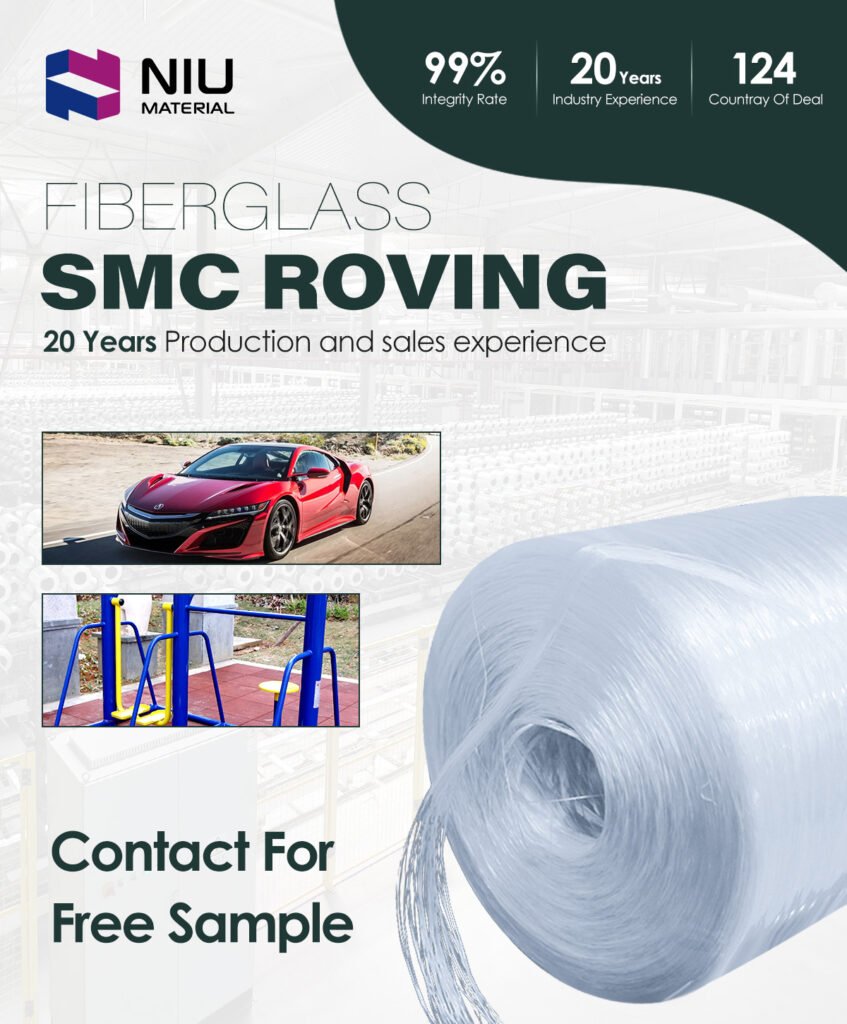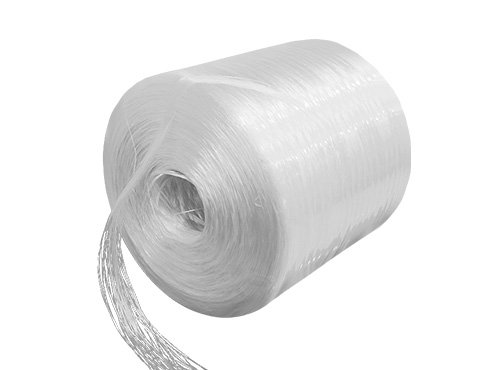
Have you ever seen a car chassis made from seemingly simple sheets of material? What about the lightweight yet very strong body panels of high-performance vehicles? How do manufacturers achieve the perfect balance of strength and weight? In this blog, we will demystify fiberglass assembly rovings SMC, explore the process of SMC roving glass fiber, and understand its critical role in modern manufacturing.
SMC roving, or Sheet Molding Compound roving, is a fundamental component in the realm of composite materials, particularly those involving fiberglass. To understand SMC roving, envision it as the essential building block that provides structural integrity and strength to a variety of molded products. Essentially, SMC roving comprises bundles of continuous glass fibers that are assembled into a unified strand or roving.
The formation of SMC roving starts with the production of glass fibers. These fibers are created by melting raw materials like silica sand, limestone, and other minerals at extremely high temperatures. The molten glass is then extruded through small holes to form fine filaments, which are gathered and twisted into rovings. These rovings possess exceptional tensile strength and are resistant to environmental degradation, making them ideal for use in composite materials.
One of the standout features of SMC roving is its versatility. It can be tailored to meet specific performance requirements by adjusting the type and proportion of glass fibers and resin. This customization enables manufacturers to produce components with a wide range of properties, from high-strength structural parts to lightweight panels with excellent surface finishes.
In summary, fiberglass SMC roving is a critical element in the production of high-performance composite materials. Its ability to provide strength, durability, and versatility makes it a cornerstone of modern manufacturing processes. Whether it’s used in the automotive industry to create lightweight, fuel-efficient vehicles or in the construction sector for robust, durable building materials, SMC roving continues to be a vital component in the advancement of composite technology.
In the context of fiberglass, SMC stands for Sheet Molding Compound. This term may sound technical, but it essentially refers to a ready-to-mold composite material used in various high-strength applications. The creation and utilization of SMC in fiberglass manufacturing represent a significant leap in materials engineering, enabling the production of complex and durable components with precision and efficiency.
SMC is a composite material made up of glass fiber reinforcements, typically in the form of rovings, which are mixed with a thermosetting resin, such as polyester or vinyl ester. Additionally, the compound includes fillers, stabilizers, and other additives to enhance its performance characteristics. The result is a malleable sheet that can be easily molded into intricate shapes under heat and pressure, making it highly versatile for numerous applications.

The use of SMC in fiberglass is particularly prominent in the automotive industry, where it is used to manufacture body panels, bumpers, and other structural components. The material’s high strength-to-weight ratio makes it an excellent choice for reducing vehicle weight, improving fuel efficiency, and enhancing performance.
Prepreg and fiberglass SMC roving are both essential materials in the realm of composite manufacturing, yet they serve different purposes and possess distinct characteristics. Understanding these differences is crucial for selecting the appropriate material for specific applications, whether it’s for high-performance aerospace components or robust automotive parts.
Prepreg, short for pre-impregnated, refers to a composite material where the reinforcement fibers (such as carbon, glass, or aramid) are pre-impregnated with a resin system, typically an epoxy. This pre-impregnation process ensures that the fibers are uniformly coated with resin, providing consistent mechanical properties and reducing the likelihood of voids or imperfections. Prepreg materials are stored in a controlled environment to prevent premature curing, often at low temperatures, until they are ready for use.
The primary advantage of prepreg is its ability to produce high-performance components with precise control over fiber orientation and resin content. This control leads to superior mechanical properties, such as high strength, stiffness, and fatigue resistance, making prepreg the material of choice for aerospace, sporting goods, and high-end automotive applications. The pre-impregnated fibers are typically laid up in molds in specific orientations to achieve the desired structural characteristics, then cured under heat and pressure in an autoclave or oven to form a solid, rigid component.
On the other hand, fiberglass SMC roving is a key ingredient in Sheet Molding Compound, a composite material used to produce large, complex parts with high strength and durability. SMC roving consists of bundles of continuous glass fibers that are chopped into shorter lengths and mixed with a thermosetting resin, fillers, and other additives. This mixture forms a pliable sheet that can be molded into various shapes under heat and pressure.
The significant difference between prepreg and SMC roving glass fiber lies in their composition and processing methods. While prepreg involves fibers pre-impregnated with resin, SMC roving combines chopped fibers with resin and other materials to create a moldable compound. This difference results in distinct advantages and applications for each material.
Prepregs are ideal for applications requiring high precision and performance, such as aircraft wings, fuselages, and high-performance sports equipment. The ability to control fiber orientation and resin content allows for the creation of components with exceptional mechanical properties tailored to specific performance requirements. However, the production process for prepreg components is more complex and expensive, involving meticulous layup procedures and specialized curing equipment.
In contrast, SMC fiberglass roving is favored for its versatility and cost-effectiveness in producing large, complex parts. The SMC process allows for high-volume production with minimal waste, making it suitable for automotive body panels, electrical enclosures, and various structural components. While SMC components may not match the performance of prepreg materials in terms of strength and stiffness, they offer excellent durability, impact resistance, and environmental stability at a lower cost.
SMC material is highly valued in insulation applications due to its exceptional thermal and electrical insulating properties. Sheet Molding Compound (SMC) combines glass fibers with a thermosetting resin matrix, resulting in a composite material that offers superior strength, durability, and resistance to heat and electricity. These characteristics make SMC an ideal choice for various insulation purposes across multiple industries, including automotive, electrical, and construction.
Another significant application of SMC in insulation is found in the electrical industry. SMC fiberglass roving materials are used to produce electrical enclosures, switchgear, and distribution boxes. These components must provide reliable insulation to prevent electrical currents from escaping and causing short circuits or other hazards. The glass fibers in SMC provide mechanical strength, while the resin matrix offers excellent electrical insulation, ensuring the safe and efficient operation of electrical systems.
The versatility of SMC roving glass fiber materials allows for their use in a wide range of insulation products. These materials can be molded into complex shapes and sizes, making them suitable for custom insulation solutions in various industries. The ability to tailor the composition of SMC by adjusting the type and proportion of glass fibers and resin allows manufacturers to create insulation materials with specific properties to meet the unique requirements of different applications.
No, SMC roving is not a thermoplastic; it is a thermoset material. Understanding the distinction between thermoplastics and thermosets is crucial to grasping the unique properties and applications of SMC roving.
Thermoplastics are polymers that become pliable or moldable above a specific temperature and solidify upon cooling. This process is reversible, meaning thermoplastics can be melted and remolded multiple times without significant degradation of their properties. Common examples of thermoplastics include polyethylene, polypropylene, and polycarbonate. They are widely used in applications requiring flexibility, such as packaging, automotive parts, and consumer goods.
In contrast, thermosetting polymers, or thermosets, undergo a chemical reaction during the curing process, which forms cross-links between polymer chains, creating a rigid and inflexible structure. Once cured, thermosets cannot be remelted or remolded. This irreversibility is due to the chemical bonds formed during curing, which provide the material with its high strength, heat resistance, and dimensional stability. Common examples of thermosets include epoxy, phenolic, and polyester resins.
SMC roving, which stands for Sheet Molding Compound roving, utilizes thermosetting resins, typically unsaturated polyester or vinyl ester. The glass fibers in the SMC roving provide reinforcement, while the resin matrix binds the fibers together and cures to form a solid, rigid composite material. This curing process involves the application of heat and pressure, which initiates a chemical reaction that cross-links the polymer chains in the resin, resulting in a durable and stable material.
The thermosetting nature of SMC roving glass fiber imparts several key advantages:
However, the thermosetting nature of SMC roving also means that once the material is cured, it cannot be remelted or reshaped. This contrasts with thermoplastics, which can be recycled and remolded multiple times. As a result, the manufacturing process for SMC components must be precise and carefully controlled to ensure the desired properties and performance are achieved in the final product.
Yes, fiberglass resin can be used on SMC (Sheet Molding Compound), but there are important considerations to ensure compatibility and optimal performance. The use of fiberglass resin on SMC materials can enhance the composite’s strength, durability, and overall performance, but it’s essential to understand the specifics of both the resin and the SMC material to achieve the best results.
In summary, fiberglass resin can be effectively used on SMC to enhance the composite’s properties, but careful consideration of compatibility, surface preparation, application method, and curing process is essential. When done correctly, the combination of fiberglass resin and SMC can result in a strong, durable, and high-performance composite material suitable for a wide range of demanding applications. Understanding these factors ensures that the full potential of both the fiberglass resin and the SMC material is realized, delivering optimal performance in the final product.
The world of fiberglass SMC rovings is a fascinating blend of science, engineering, and creativity. From making lightweight, durable automotive parts to insulation and beyond, SMC fiberglass rovings are a critical material in modern manufacturing.
In short, fiberglass assembly rovings SMC combine the strength of fiberglass with the versatility of thermoset resins. As industry continues to demand lighter, stronger, and more efficient materials, the role of SMC rovings will only become more important. So the next time you see a sleek, lightweight car or high-performance product, know that the secret to its strength and durability lies in the extraordinary world of SMC roving.

If you have any questions
Please contact us for free consultation and product quotation
Table of Contents Add a h
Table of Contents Add a h

